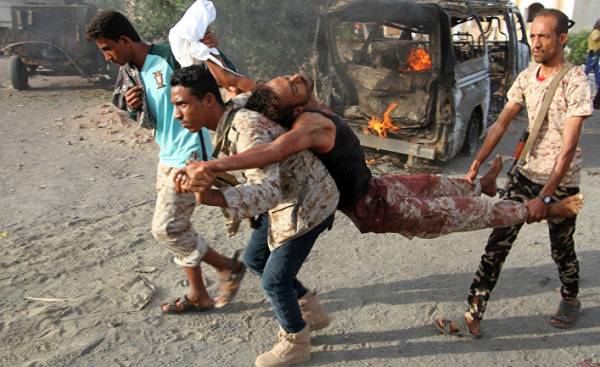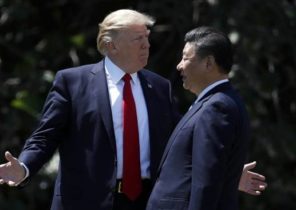
Gradually recovered health in the “body” of relations between Saudi Arabia and America. The Kingdom had been able to solve one of the most important problems that beset it during complex operations in Yemen. But Yemenis still faced with those complicated questions, indecision, and ambiguity and vagueness of the position of the Alliance in the country.
A week ago the Minister of defence of the USA James Mattis arrived in Riyadh and began his tour of the region. He enthusiastically talked about U.S.-Saudi relations, expressed warning to Iran, and also touched upon the issue concerns Saudi Arabia about the continuing rocket fire from areas of Yemen controlled by the Houthis, supported by Iran.
In turn, the Minister reintroduced the Yemen crisis on the agenda of the United States, pointing out that the priority for his country is the return of the Yemeni issues on the table of international negotiations. We don’t need to exert much effort in order to understand what the U.S. priorities remain the same as was on the entire way, namely: to provide maximum and complete resistance to what Washington calls “terrorism.” I, like many observers, it is commonly believed that the next negotiations between the government and the rebels will be a cover for a redrawing and restructuring of the political picture can be redistributed to actors on this stage, pre-excluding the Islamists.
While there are no guarantees that the current US administration will provide an opportunity for the Houthis to take advantage of the political situation that trump is considering as a way to resolve the conflict in Yemen. Despite strong statements by senior American officials, including the Minister for foreign Affairs and defence, they act against Iran, which, in turn, benefited from the strengthening of influence of the militants of the Houthis.
I find no more convincing evidence than the vision of the President and his government, able to exercise freely their activities in the territories liberated from illegal authorities, however, imprisoned by various regional illusions, conflicts and misconceptions. The government is able to control and govern the country without restrictions, while in the temporary political capital (after the takeover by the Houthis of the capital Sana’a in January 2015, the provisional capital was declared Aden — approx. ed.).
Now more than ever, President Abd-rabbu Mansour Hadi is confident that he is forced to stay in Riyadh with Minister of the country because of increasing tension between legitimate authority and Abu Dhabi on the other. Temporary political capital, at the same time, step by step turns into a big camp, where troops and battalions, using different regional colors and banners. Moreover, it becomes like a maze of prisons in which to go into the demonstrators have not yet cut their connection with life.
This pathetic situation is entrenched in the Arab Alliance. The second strength of this Union is definitely in no way an indication of compliance between the stated priority goals of this Alliance and what is really happening in the country.
Abu Dhabi fully supports and agrees with the objectives of the United States, which are associated with the opposition, the so-called Sunni “terrorism” and not to strengthen and empower Yemenis to restore peace in the country. That’s why trump is trying to bring the issue on the agenda, under the guise of false pretenses, which in turn leads to questions about trust: is it on the agenda of the United States is fighting terrorism?!
In light of such selectivity, which we observe in the choice of objectives of the US and the UAE, noting that the issues of “ISIS” (banned in Russia — approx. ed.) are ignored or even excluded from the list.
Actually not far from the place which was attacked by Americans, concentrated force ISIS, which captured the southern provinces. The only question is, is there some unspoken agreement to join ISIS in these areas?!
The most powerful argument to support the existence of such an agreement, this is a huge number of ISIL militants in the areas dominated by the national resistance, whose interests, in turn, coincide and are consistent with the agenda of the coalition, despite the fact that they do not collide with them. Followers of ISIS begin to have an effect on the forces of national resistance with the aim of becoming controlled areas into hotbeds of terrorism, which subsequently will facilitate the blackmail, will contribute to “taming” or at all will lead to the termination of the influence of the resistance forces, and their destruction, if necessary.
The UAE relies on a strong military influence in Aden, which, in turn, extends to Bab-El-Mandeb Strait and the West coast. If we look at the field of battle that enveloped currently the coast of Yemen, we find that the Arab coalition depends on the battalions formed from the forces military and South block resistance. Moreover, increasingly it relies on battalions of the Sudanese army, directly involved in fighting on the side of the coalition forces.
At some point there was a possibility of joining the battalion of the military divisions of the people of TA’izz, however, unfortunately, this did not happen.
Current measures to liberate the province of al-Hudaydah are no different from those that we saw in the Bab-El-Mandee and Mahce. This development is explained by the slow action of the military forces subordinate to the government and the coalition.
The Arab Alliance has chosen a very complicated and convoluted scheme to achieve quite simple goals in Yemen. One of the reasons for this is the pressure tactics of U.S. priorities, as well as the preservation of the rigid positions of all the countries in the coalition on this issue. To the extent “fresh” in the memory of the consequences of the “Arab spring” that the coalition may not be in a hurry to defeat the government, supported by Iran and came as a result of a coup.







